Patient and Family-Centred Care Essay: Asthma and Pediatric Nursing
VerifiedAdded on 2022/08/12
|10
|3135
|15
Essay
AI Summary
This essay delves into the principles of patient and family-centered care (P&FCC) within the context of pediatric nursing, specifically addressing the management of acute asthma. It begins by outlining the presenting condition of acute asthma, including its symptoms, diagnosis, and treatment modalities. The essay then defines P&FCC in pediatric nursing, emphasizing the importance of partnership between patients, families, and healthcare providers. It identifies and analyzes three key stressors of hospitalization that children and their families may experience, such as noise, parental anxiety, and lack of parental availability, and proposes corresponding nursing interventions to mitigate these stressors. Furthermore, the essay describes how nurses can implement P&FCC principles, including respect and dignity, information sharing, patient and family participation in decision-making, and collaborative care, to improve patient outcomes. Finally, the importance of discharge education is discussed, outlining strategies to empower families in managing the child's health at home.
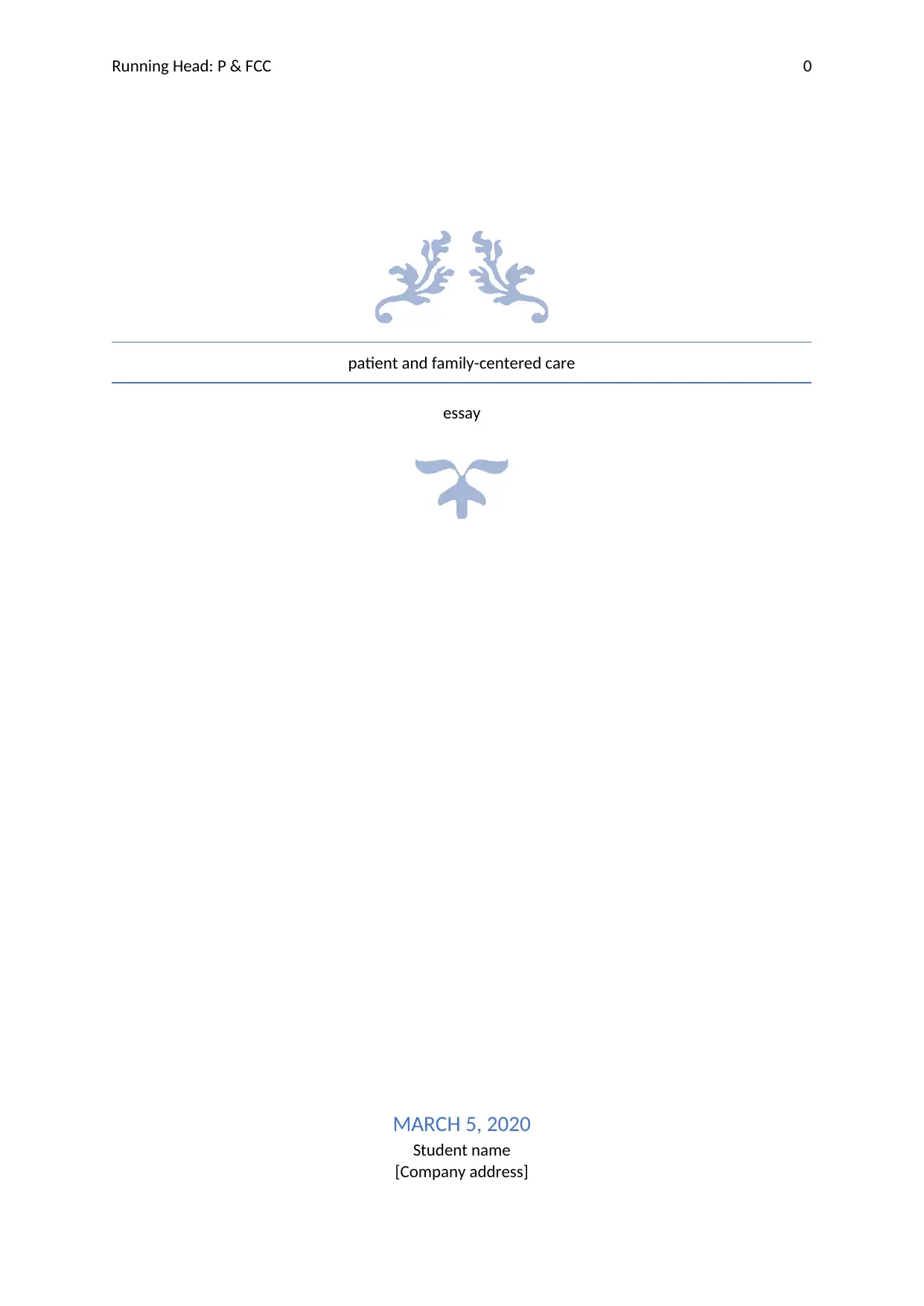
Running Head: P & FCC 0
patient and family-centered care
essay
MARCH 5, 2020
Student name
[Company address]
patient and family-centered care
essay
MARCH 5, 2020
Student name
[Company address]
Paraphrase This Document
Need a fresh take? Get an instant paraphrase of this document with our AI Paraphraser
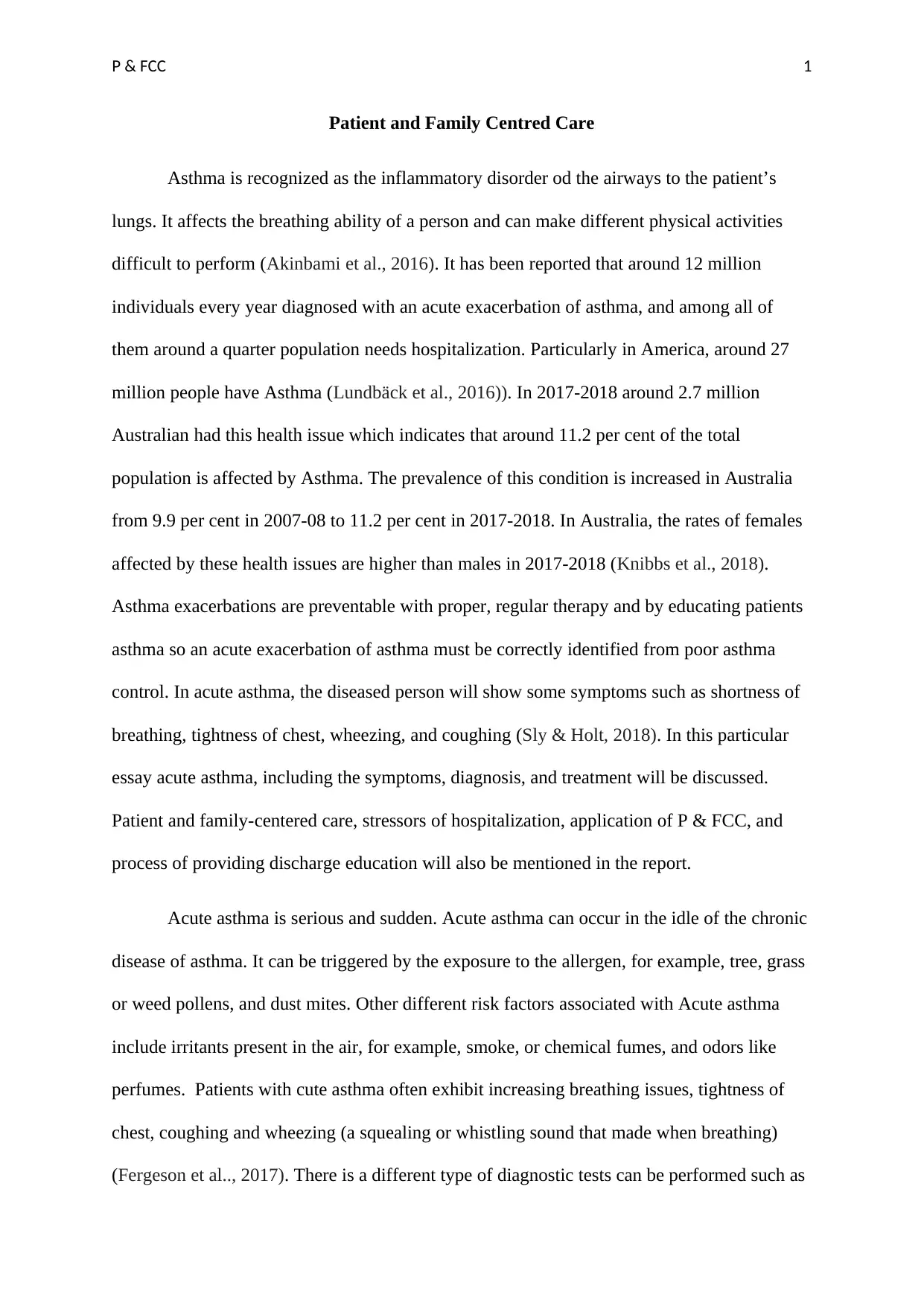
P & FCC 1
Patient and Family Centred Care
Asthma is recognized as the inflammatory disorder od the airways to the patient’s
lungs. It affects the breathing ability of a person and can make different physical activities
difficult to perform (Akinbami et al., 2016). It has been reported that around 12 million
individuals every year diagnosed with an acute exacerbation of asthma, and among all of
them around a quarter population needs hospitalization. Particularly in America, around 27
million people have Asthma (Lundbäck et al., 2016)). In 2017-2018 around 2.7 million
Australian had this health issue which indicates that around 11.2 per cent of the total
population is affected by Asthma. The prevalence of this condition is increased in Australia
from 9.9 per cent in 2007-08 to 11.2 per cent in 2017-2018. In Australia, the rates of females
affected by these health issues are higher than males in 2017-2018 (Knibbs et al., 2018).
Asthma exacerbations are preventable with proper, regular therapy and by educating patients
asthma so an acute exacerbation of asthma must be correctly identified from poor asthma
control. In acute asthma, the diseased person will show some symptoms such as shortness of
breathing, tightness of chest, wheezing, and coughing (Sly & Holt, 2018). In this particular
essay acute asthma, including the symptoms, diagnosis, and treatment will be discussed.
Patient and family-centered care, stressors of hospitalization, application of P & FCC, and
process of providing discharge education will also be mentioned in the report.
Acute asthma is serious and sudden. Acute asthma can occur in the idle of the chronic
disease of asthma. It can be triggered by the exposure to the allergen, for example, tree, grass
or weed pollens, and dust mites. Other different risk factors associated with Acute asthma
include irritants present in the air, for example, smoke, or chemical fumes, and odors like
perfumes. Patients with cute asthma often exhibit increasing breathing issues, tightness of
chest, coughing and wheezing (a squealing or whistling sound that made when breathing)
(Fergeson et al.., 2017). There is a different type of diagnostic tests can be performed such as
Patient and Family Centred Care
Asthma is recognized as the inflammatory disorder od the airways to the patient’s
lungs. It affects the breathing ability of a person and can make different physical activities
difficult to perform (Akinbami et al., 2016). It has been reported that around 12 million
individuals every year diagnosed with an acute exacerbation of asthma, and among all of
them around a quarter population needs hospitalization. Particularly in America, around 27
million people have Asthma (Lundbäck et al., 2016)). In 2017-2018 around 2.7 million
Australian had this health issue which indicates that around 11.2 per cent of the total
population is affected by Asthma. The prevalence of this condition is increased in Australia
from 9.9 per cent in 2007-08 to 11.2 per cent in 2017-2018. In Australia, the rates of females
affected by these health issues are higher than males in 2017-2018 (Knibbs et al., 2018).
Asthma exacerbations are preventable with proper, regular therapy and by educating patients
asthma so an acute exacerbation of asthma must be correctly identified from poor asthma
control. In acute asthma, the diseased person will show some symptoms such as shortness of
breathing, tightness of chest, wheezing, and coughing (Sly & Holt, 2018). In this particular
essay acute asthma, including the symptoms, diagnosis, and treatment will be discussed.
Patient and family-centered care, stressors of hospitalization, application of P & FCC, and
process of providing discharge education will also be mentioned in the report.
Acute asthma is serious and sudden. Acute asthma can occur in the idle of the chronic
disease of asthma. It can be triggered by the exposure to the allergen, for example, tree, grass
or weed pollens, and dust mites. Other different risk factors associated with Acute asthma
include irritants present in the air, for example, smoke, or chemical fumes, and odors like
perfumes. Patients with cute asthma often exhibit increasing breathing issues, tightness of
chest, coughing and wheezing (a squealing or whistling sound that made when breathing)
(Fergeson et al.., 2017). There is a different type of diagnostic tests can be performed such as
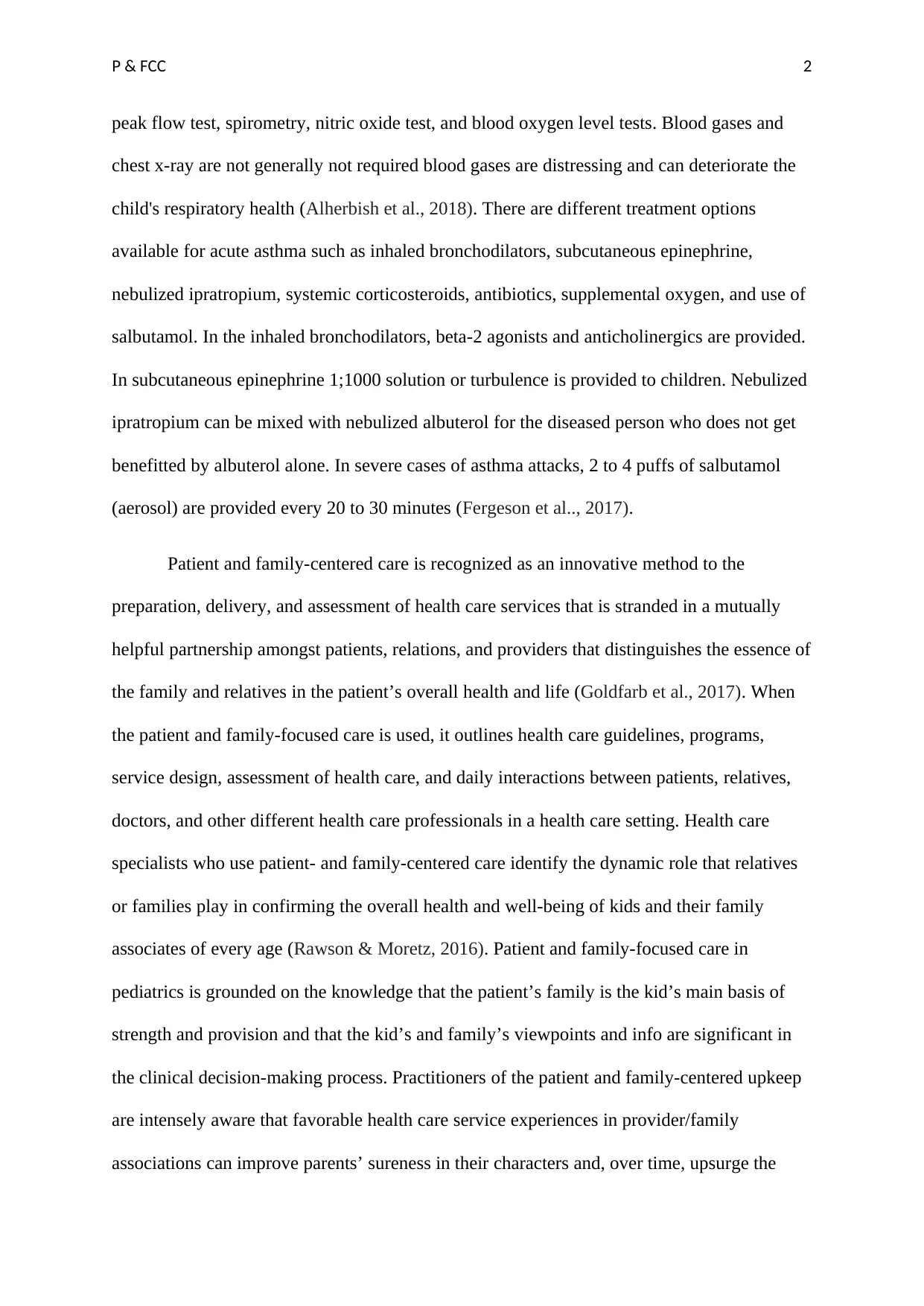
P & FCC 2
peak flow test, spirometry, nitric oxide test, and blood oxygen level tests. Blood gases and
chest x-ray are not generally not required blood gases are distressing and can deteriorate the
child's respiratory health (Alherbish et al., 2018). There are different treatment options
available for acute asthma such as inhaled bronchodilators, subcutaneous epinephrine,
nebulized ipratropium, systemic corticosteroids, antibiotics, supplemental oxygen, and use of
salbutamol. In the inhaled bronchodilators, beta-2 agonists and anticholinergics are provided.
In subcutaneous epinephrine 1;1000 solution or turbulence is provided to children. Nebulized
ipratropium can be mixed with nebulized albuterol for the diseased person who does not get
benefitted by albuterol alone. In severe cases of asthma attacks, 2 to 4 puffs of salbutamol
(aerosol) are provided every 20 to 30 minutes (Fergeson et al.., 2017).
Patient and family-centered care is recognized as an innovative method to the
preparation, delivery, and assessment of health care services that is stranded in a mutually
helpful partnership amongst patients, relations, and providers that distinguishes the essence of
the family and relatives in the patient’s overall health and life (Goldfarb et al., 2017). When
the patient and family-focused care is used, it outlines health care guidelines, programs,
service design, assessment of health care, and daily interactions between patients, relatives,
doctors, and other different health care professionals in a health care setting. Health care
specialists who use patient- and family-centered care identify the dynamic role that relatives
or families play in confirming the overall health and well-being of kids and their family
associates of every age (Rawson & Moretz, 2016). Patient and family-focused care in
pediatrics is grounded on the knowledge that the patient’s family is the kid’s main basis of
strength and provision and that the kid’s and family’s viewpoints and info are significant in
the clinical decision-making process. Practitioners of the patient and family-centered upkeep
are intensely aware that favorable health care service experiences in provider/family
associations can improve parents’ sureness in their characters and, over time, upsurge the
peak flow test, spirometry, nitric oxide test, and blood oxygen level tests. Blood gases and
chest x-ray are not generally not required blood gases are distressing and can deteriorate the
child's respiratory health (Alherbish et al., 2018). There are different treatment options
available for acute asthma such as inhaled bronchodilators, subcutaneous epinephrine,
nebulized ipratropium, systemic corticosteroids, antibiotics, supplemental oxygen, and use of
salbutamol. In the inhaled bronchodilators, beta-2 agonists and anticholinergics are provided.
In subcutaneous epinephrine 1;1000 solution or turbulence is provided to children. Nebulized
ipratropium can be mixed with nebulized albuterol for the diseased person who does not get
benefitted by albuterol alone. In severe cases of asthma attacks, 2 to 4 puffs of salbutamol
(aerosol) are provided every 20 to 30 minutes (Fergeson et al.., 2017).
Patient and family-centered care is recognized as an innovative method to the
preparation, delivery, and assessment of health care services that is stranded in a mutually
helpful partnership amongst patients, relations, and providers that distinguishes the essence of
the family and relatives in the patient’s overall health and life (Goldfarb et al., 2017). When
the patient and family-focused care is used, it outlines health care guidelines, programs,
service design, assessment of health care, and daily interactions between patients, relatives,
doctors, and other different health care professionals in a health care setting. Health care
specialists who use patient- and family-centered care identify the dynamic role that relatives
or families play in confirming the overall health and well-being of kids and their family
associates of every age (Rawson & Moretz, 2016). Patient and family-focused care in
pediatrics is grounded on the knowledge that the patient’s family is the kid’s main basis of
strength and provision and that the kid’s and family’s viewpoints and info are significant in
the clinical decision-making process. Practitioners of the patient and family-centered upkeep
are intensely aware that favorable health care service experiences in provider/family
associations can improve parents’ sureness in their characters and, over time, upsurge the
⊘ This is a preview!⊘
Do you want full access?
Subscribe today to unlock all pages.

Trusted by 1+ million students worldwide
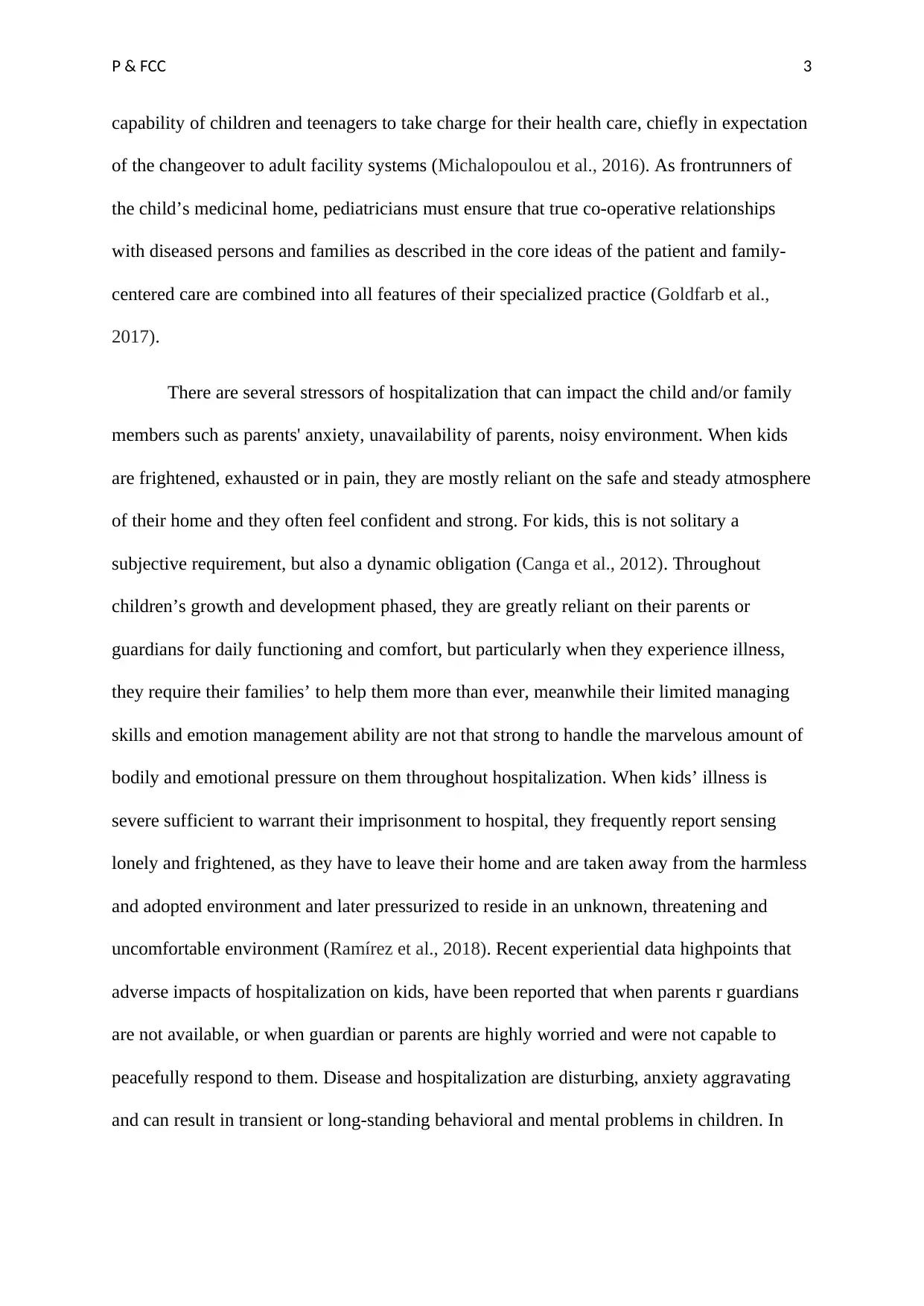
P & FCC 3
capability of children and teenagers to take charge for their health care, chiefly in expectation
of the changeover to adult facility systems (Michalopoulou et al., 2016). As frontrunners of
the child’s medicinal home, pediatricians must ensure that true co-operative relationships
with diseased persons and families as described in the core ideas of the patient and family-
centered care are combined into all features of their specialized practice (Goldfarb et al.,
2017).
There are several stressors of hospitalization that can impact the child and/or family
members such as parents' anxiety, unavailability of parents, noisy environment. When kids
are frightened, exhausted or in pain, they are mostly reliant on the safe and steady atmosphere
of their home and they often feel confident and strong. For kids, this is not solitary a
subjective requirement, but also a dynamic obligation (Canga et al., 2012). Throughout
children’s growth and development phased, they are greatly reliant on their parents or
guardians for daily functioning and comfort, but particularly when they experience illness,
they require their families’ to help them more than ever, meanwhile their limited managing
skills and emotion management ability are not that strong to handle the marvelous amount of
bodily and emotional pressure on them throughout hospitalization. When kids’ illness is
severe sufficient to warrant their imprisonment to hospital, they frequently report sensing
lonely and frightened, as they have to leave their home and are taken away from the harmless
and adopted environment and later pressurized to reside in an unknown, threatening and
uncomfortable environment (Ramírez et al., 2018). Recent experiential data highpoints that
adverse impacts of hospitalization on kids, have been reported that when parents r guardians
are not available, or when guardian or parents are highly worried and were not capable to
peacefully respond to them. Disease and hospitalization are disturbing, anxiety aggravating
and can result in transient or long-standing behavioral and mental problems in children. In
capability of children and teenagers to take charge for their health care, chiefly in expectation
of the changeover to adult facility systems (Michalopoulou et al., 2016). As frontrunners of
the child’s medicinal home, pediatricians must ensure that true co-operative relationships
with diseased persons and families as described in the core ideas of the patient and family-
centered care are combined into all features of their specialized practice (Goldfarb et al.,
2017).
There are several stressors of hospitalization that can impact the child and/or family
members such as parents' anxiety, unavailability of parents, noisy environment. When kids
are frightened, exhausted or in pain, they are mostly reliant on the safe and steady atmosphere
of their home and they often feel confident and strong. For kids, this is not solitary a
subjective requirement, but also a dynamic obligation (Canga et al., 2012). Throughout
children’s growth and development phased, they are greatly reliant on their parents or
guardians for daily functioning and comfort, but particularly when they experience illness,
they require their families’ to help them more than ever, meanwhile their limited managing
skills and emotion management ability are not that strong to handle the marvelous amount of
bodily and emotional pressure on them throughout hospitalization. When kids’ illness is
severe sufficient to warrant their imprisonment to hospital, they frequently report sensing
lonely and frightened, as they have to leave their home and are taken away from the harmless
and adopted environment and later pressurized to reside in an unknown, threatening and
uncomfortable environment (Ramírez et al., 2018). Recent experiential data highpoints that
adverse impacts of hospitalization on kids, have been reported that when parents r guardians
are not available, or when guardian or parents are highly worried and were not capable to
peacefully respond to them. Disease and hospitalization are disturbing, anxiety aggravating
and can result in transient or long-standing behavioral and mental problems in children. In
Paraphrase This Document
Need a fresh take? Get an instant paraphrase of this document with our AI Paraphraser
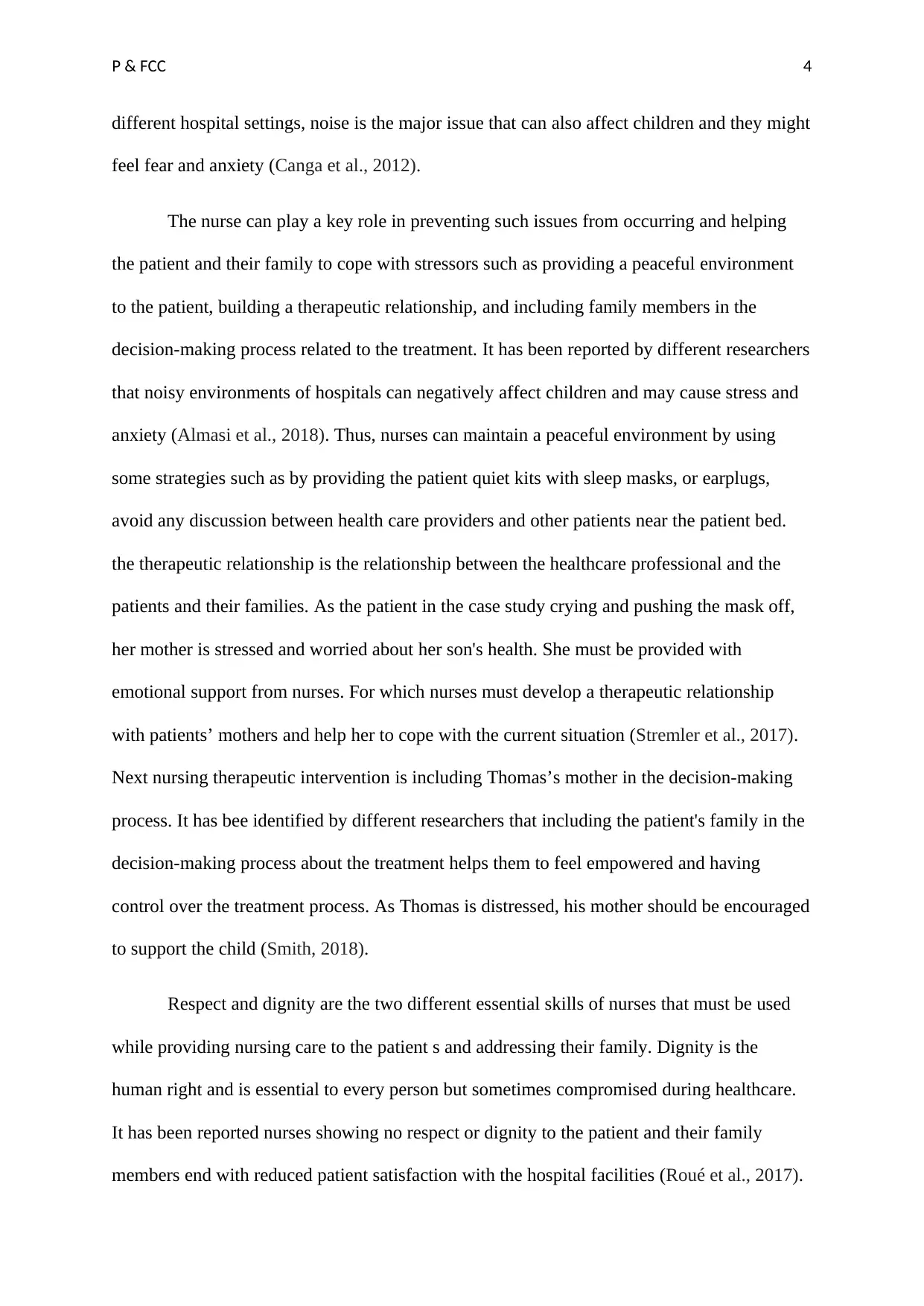
P & FCC 4
different hospital settings, noise is the major issue that can also affect children and they might
feel fear and anxiety (Canga et al., 2012).
The nurse can play a key role in preventing such issues from occurring and helping
the patient and their family to cope with stressors such as providing a peaceful environment
to the patient, building a therapeutic relationship, and including family members in the
decision-making process related to the treatment. It has been reported by different researchers
that noisy environments of hospitals can negatively affect children and may cause stress and
anxiety (Almasi et al., 2018). Thus, nurses can maintain a peaceful environment by using
some strategies such as by providing the patient quiet kits with sleep masks, or earplugs,
avoid any discussion between health care providers and other patients near the patient bed.
the therapeutic relationship is the relationship between the healthcare professional and the
patients and their families. As the patient in the case study crying and pushing the mask off,
her mother is stressed and worried about her son's health. She must be provided with
emotional support from nurses. For which nurses must develop a therapeutic relationship
with patients’ mothers and help her to cope with the current situation (Stremler et al., 2017).
Next nursing therapeutic intervention is including Thomas’s mother in the decision-making
process. It has bee identified by different researchers that including the patient's family in the
decision-making process about the treatment helps them to feel empowered and having
control over the treatment process. As Thomas is distressed, his mother should be encouraged
to support the child (Smith, 2018).
Respect and dignity are the two different essential skills of nurses that must be used
while providing nursing care to the patient s and addressing their family. Dignity is the
human right and is essential to every person but sometimes compromised during healthcare.
It has been reported nurses showing no respect or dignity to the patient and their family
members end with reduced patient satisfaction with the hospital facilities (Roué et al., 2017).
different hospital settings, noise is the major issue that can also affect children and they might
feel fear and anxiety (Canga et al., 2012).
The nurse can play a key role in preventing such issues from occurring and helping
the patient and their family to cope with stressors such as providing a peaceful environment
to the patient, building a therapeutic relationship, and including family members in the
decision-making process related to the treatment. It has been reported by different researchers
that noisy environments of hospitals can negatively affect children and may cause stress and
anxiety (Almasi et al., 2018). Thus, nurses can maintain a peaceful environment by using
some strategies such as by providing the patient quiet kits with sleep masks, or earplugs,
avoid any discussion between health care providers and other patients near the patient bed.
the therapeutic relationship is the relationship between the healthcare professional and the
patients and their families. As the patient in the case study crying and pushing the mask off,
her mother is stressed and worried about her son's health. She must be provided with
emotional support from nurses. For which nurses must develop a therapeutic relationship
with patients’ mothers and help her to cope with the current situation (Stremler et al., 2017).
Next nursing therapeutic intervention is including Thomas’s mother in the decision-making
process. It has bee identified by different researchers that including the patient's family in the
decision-making process about the treatment helps them to feel empowered and having
control over the treatment process. As Thomas is distressed, his mother should be encouraged
to support the child (Smith, 2018).
Respect and dignity are the two different essential skills of nurses that must be used
while providing nursing care to the patient s and addressing their family. Dignity is the
human right and is essential to every person but sometimes compromised during healthcare.
It has been reported nurses showing no respect or dignity to the patient and their family
members end with reduced patient satisfaction with the hospital facilities (Roué et al., 2017).
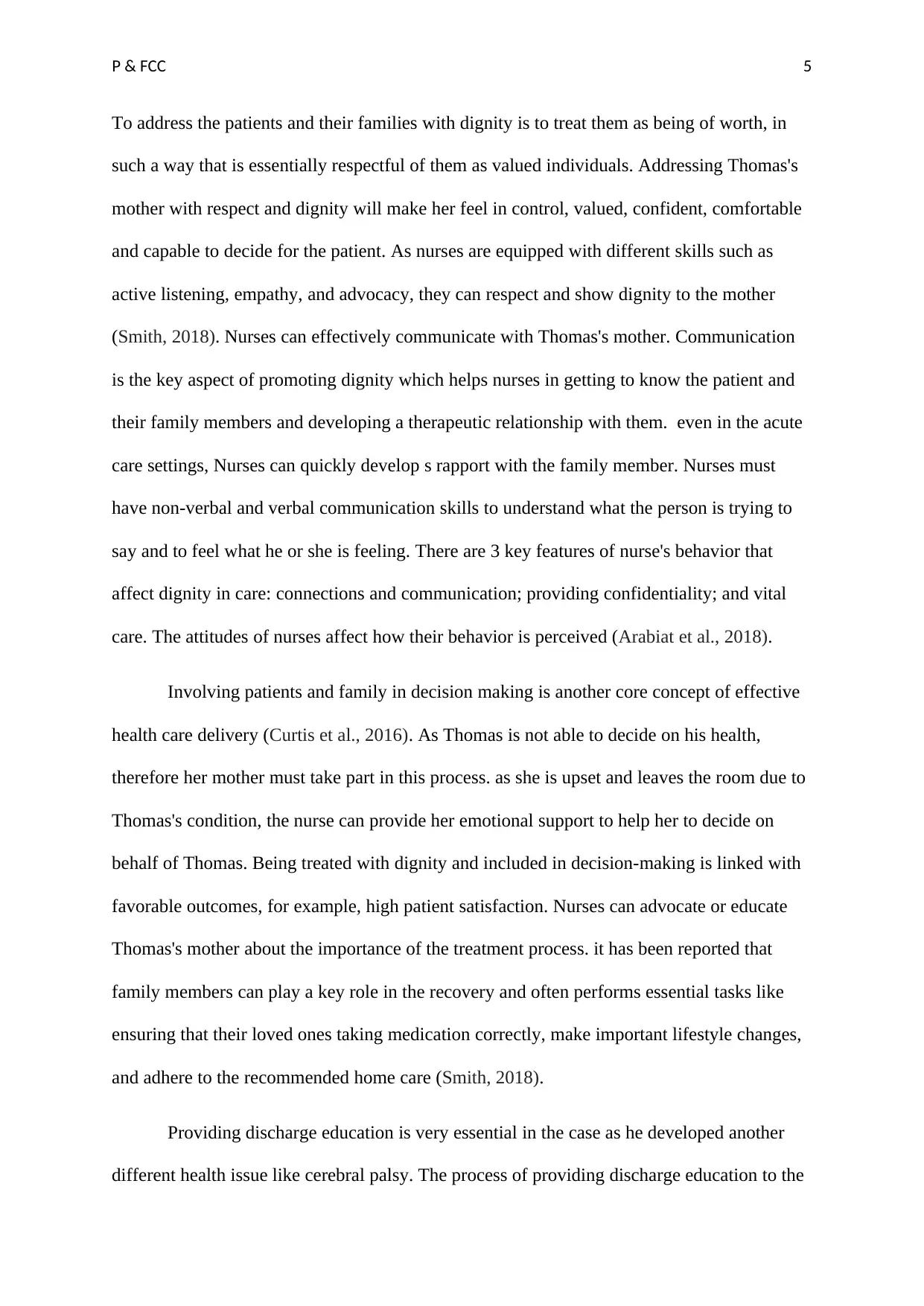
P & FCC 5
To address the patients and their families with dignity is to treat them as being of worth, in
such a way that is essentially respectful of them as valued individuals. Addressing Thomas's
mother with respect and dignity will make her feel in control, valued, confident, comfortable
and capable to decide for the patient. As nurses are equipped with different skills such as
active listening, empathy, and advocacy, they can respect and show dignity to the mother
(Smith, 2018). Nurses can effectively communicate with Thomas's mother. Communication
is the key aspect of promoting dignity which helps nurses in getting to know the patient and
their family members and developing a therapeutic relationship with them. even in the acute
care settings, Nurses can quickly develop s rapport with the family member. Nurses must
have non-verbal and verbal communication skills to understand what the person is trying to
say and to feel what he or she is feeling. There are 3 key features of nurse's behavior that
affect dignity in care: connections and communication; providing confidentiality; and vital
care. The attitudes of nurses affect how their behavior is perceived (Arabiat et al., 2018).
Involving patients and family in decision making is another core concept of effective
health care delivery (Curtis et al., 2016). As Thomas is not able to decide on his health,
therefore her mother must take part in this process. as she is upset and leaves the room due to
Thomas's condition, the nurse can provide her emotional support to help her to decide on
behalf of Thomas. Being treated with dignity and included in decision-making is linked with
favorable outcomes, for example, high patient satisfaction. Nurses can advocate or educate
Thomas's mother about the importance of the treatment process. it has been reported that
family members can play a key role in the recovery and often performs essential tasks like
ensuring that their loved ones taking medication correctly, make important lifestyle changes,
and adhere to the recommended home care (Smith, 2018).
Providing discharge education is very essential in the case as he developed another
different health issue like cerebral palsy. The process of providing discharge education to the
To address the patients and their families with dignity is to treat them as being of worth, in
such a way that is essentially respectful of them as valued individuals. Addressing Thomas's
mother with respect and dignity will make her feel in control, valued, confident, comfortable
and capable to decide for the patient. As nurses are equipped with different skills such as
active listening, empathy, and advocacy, they can respect and show dignity to the mother
(Smith, 2018). Nurses can effectively communicate with Thomas's mother. Communication
is the key aspect of promoting dignity which helps nurses in getting to know the patient and
their family members and developing a therapeutic relationship with them. even in the acute
care settings, Nurses can quickly develop s rapport with the family member. Nurses must
have non-verbal and verbal communication skills to understand what the person is trying to
say and to feel what he or she is feeling. There are 3 key features of nurse's behavior that
affect dignity in care: connections and communication; providing confidentiality; and vital
care. The attitudes of nurses affect how their behavior is perceived (Arabiat et al., 2018).
Involving patients and family in decision making is another core concept of effective
health care delivery (Curtis et al., 2016). As Thomas is not able to decide on his health,
therefore her mother must take part in this process. as she is upset and leaves the room due to
Thomas's condition, the nurse can provide her emotional support to help her to decide on
behalf of Thomas. Being treated with dignity and included in decision-making is linked with
favorable outcomes, for example, high patient satisfaction. Nurses can advocate or educate
Thomas's mother about the importance of the treatment process. it has been reported that
family members can play a key role in the recovery and often performs essential tasks like
ensuring that their loved ones taking medication correctly, make important lifestyle changes,
and adhere to the recommended home care (Smith, 2018).
Providing discharge education is very essential in the case as he developed another
different health issue like cerebral palsy. The process of providing discharge education to the
⊘ This is a preview!⊘
Do you want full access?
Subscribe today to unlock all pages.

Trusted by 1+ million students worldwide
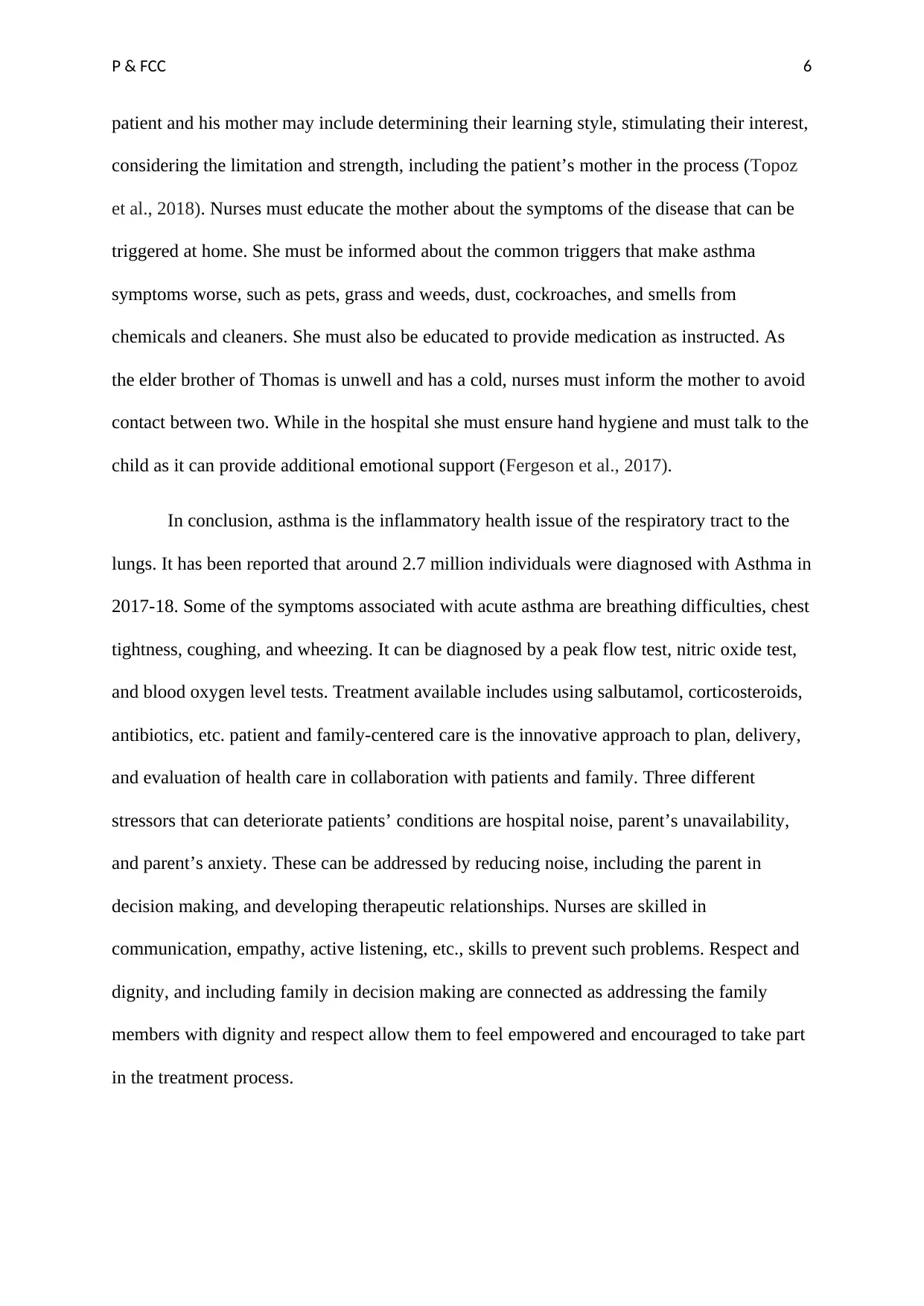
P & FCC 6
patient and his mother may include determining their learning style, stimulating their interest,
considering the limitation and strength, including the patient’s mother in the process (Topoz
et al., 2018). Nurses must educate the mother about the symptoms of the disease that can be
triggered at home. She must be informed about the common triggers that make asthma
symptoms worse, such as pets, grass and weeds, dust, cockroaches, and smells from
chemicals and cleaners. She must also be educated to provide medication as instructed. As
the elder brother of Thomas is unwell and has a cold, nurses must inform the mother to avoid
contact between two. While in the hospital she must ensure hand hygiene and must talk to the
child as it can provide additional emotional support (Fergeson et al., 2017).
In conclusion, asthma is the inflammatory health issue of the respiratory tract to the
lungs. It has been reported that around 2.7 million individuals were diagnosed with Asthma in
2017-18. Some of the symptoms associated with acute asthma are breathing difficulties, chest
tightness, coughing, and wheezing. It can be diagnosed by a peak flow test, nitric oxide test,
and blood oxygen level tests. Treatment available includes using salbutamol, corticosteroids,
antibiotics, etc. patient and family-centered care is the innovative approach to plan, delivery,
and evaluation of health care in collaboration with patients and family. Three different
stressors that can deteriorate patients’ conditions are hospital noise, parent’s unavailability,
and parent’s anxiety. These can be addressed by reducing noise, including the parent in
decision making, and developing therapeutic relationships. Nurses are skilled in
communication, empathy, active listening, etc., skills to prevent such problems. Respect and
dignity, and including family in decision making are connected as addressing the family
members with dignity and respect allow them to feel empowered and encouraged to take part
in the treatment process.
patient and his mother may include determining their learning style, stimulating their interest,
considering the limitation and strength, including the patient’s mother in the process (Topoz
et al., 2018). Nurses must educate the mother about the symptoms of the disease that can be
triggered at home. She must be informed about the common triggers that make asthma
symptoms worse, such as pets, grass and weeds, dust, cockroaches, and smells from
chemicals and cleaners. She must also be educated to provide medication as instructed. As
the elder brother of Thomas is unwell and has a cold, nurses must inform the mother to avoid
contact between two. While in the hospital she must ensure hand hygiene and must talk to the
child as it can provide additional emotional support (Fergeson et al., 2017).
In conclusion, asthma is the inflammatory health issue of the respiratory tract to the
lungs. It has been reported that around 2.7 million individuals were diagnosed with Asthma in
2017-18. Some of the symptoms associated with acute asthma are breathing difficulties, chest
tightness, coughing, and wheezing. It can be diagnosed by a peak flow test, nitric oxide test,
and blood oxygen level tests. Treatment available includes using salbutamol, corticosteroids,
antibiotics, etc. patient and family-centered care is the innovative approach to plan, delivery,
and evaluation of health care in collaboration with patients and family. Three different
stressors that can deteriorate patients’ conditions are hospital noise, parent’s unavailability,
and parent’s anxiety. These can be addressed by reducing noise, including the parent in
decision making, and developing therapeutic relationships. Nurses are skilled in
communication, empathy, active listening, etc., skills to prevent such problems. Respect and
dignity, and including family in decision making are connected as addressing the family
members with dignity and respect allow them to feel empowered and encouraged to take part
in the treatment process.
Paraphrase This Document
Need a fresh take? Get an instant paraphrase of this document with our AI Paraphraser
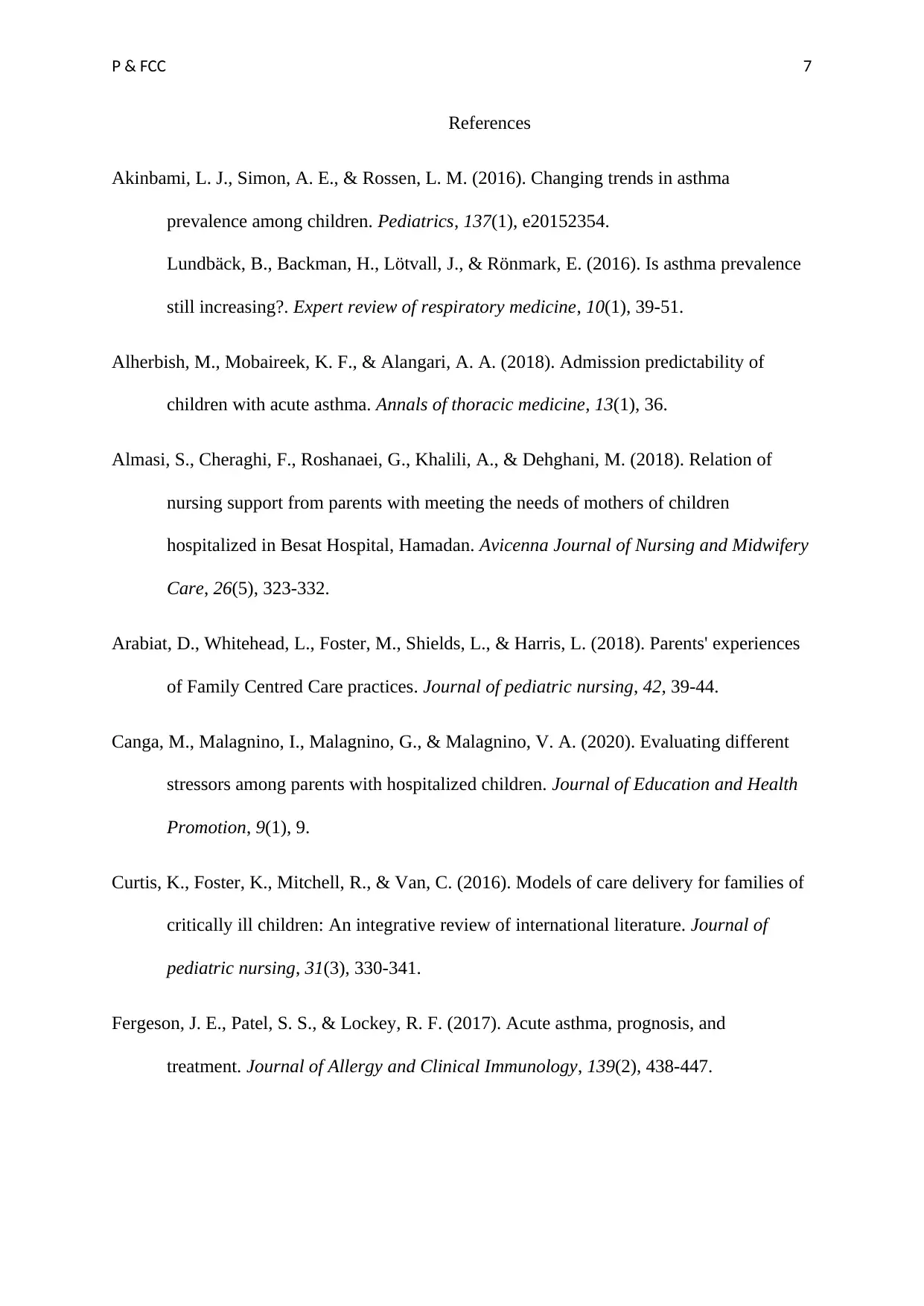
P & FCC 7
References
Akinbami, L. J., Simon, A. E., & Rossen, L. M. (2016). Changing trends in asthma
prevalence among children. Pediatrics, 137(1), e20152354.
Lundbäck, B., Backman, H., Lötvall, J., & Rönmark, E. (2016). Is asthma prevalence
still increasing?. Expert review of respiratory medicine, 10(1), 39-51.
Alherbish, M., Mobaireek, K. F., & Alangari, A. A. (2018). Admission predictability of
children with acute asthma. Annals of thoracic medicine, 13(1), 36.
Almasi, S., Cheraghi, F., Roshanaei, G., Khalili, A., & Dehghani, M. (2018). Relation of
nursing support from parents with meeting the needs of mothers of children
hospitalized in Besat Hospital, Hamadan. Avicenna Journal of Nursing and Midwifery
Care, 26(5), 323-332.
Arabiat, D., Whitehead, L., Foster, M., Shields, L., & Harris, L. (2018). Parents' experiences
of Family Centred Care practices. Journal of pediatric nursing, 42, 39-44.
Canga, M., Malagnino, I., Malagnino, G., & Malagnino, V. A. (2020). Evaluating different
stressors among parents with hospitalized children. Journal of Education and Health
Promotion, 9(1), 9.
Curtis, K., Foster, K., Mitchell, R., & Van, C. (2016). Models of care delivery for families of
critically ill children: An integrative review of international literature. Journal of
pediatric nursing, 31(3), 330-341.
Fergeson, J. E., Patel, S. S., & Lockey, R. F. (2017). Acute asthma, prognosis, and
treatment. Journal of Allergy and Clinical Immunology, 139(2), 438-447.
References
Akinbami, L. J., Simon, A. E., & Rossen, L. M. (2016). Changing trends in asthma
prevalence among children. Pediatrics, 137(1), e20152354.
Lundbäck, B., Backman, H., Lötvall, J., & Rönmark, E. (2016). Is asthma prevalence
still increasing?. Expert review of respiratory medicine, 10(1), 39-51.
Alherbish, M., Mobaireek, K. F., & Alangari, A. A. (2018). Admission predictability of
children with acute asthma. Annals of thoracic medicine, 13(1), 36.
Almasi, S., Cheraghi, F., Roshanaei, G., Khalili, A., & Dehghani, M. (2018). Relation of
nursing support from parents with meeting the needs of mothers of children
hospitalized in Besat Hospital, Hamadan. Avicenna Journal of Nursing and Midwifery
Care, 26(5), 323-332.
Arabiat, D., Whitehead, L., Foster, M., Shields, L., & Harris, L. (2018). Parents' experiences
of Family Centred Care practices. Journal of pediatric nursing, 42, 39-44.
Canga, M., Malagnino, I., Malagnino, G., & Malagnino, V. A. (2020). Evaluating different
stressors among parents with hospitalized children. Journal of Education and Health
Promotion, 9(1), 9.
Curtis, K., Foster, K., Mitchell, R., & Van, C. (2016). Models of care delivery for families of
critically ill children: An integrative review of international literature. Journal of
pediatric nursing, 31(3), 330-341.
Fergeson, J. E., Patel, S. S., & Lockey, R. F. (2017). Acute asthma, prognosis, and
treatment. Journal of Allergy and Clinical Immunology, 139(2), 438-447.
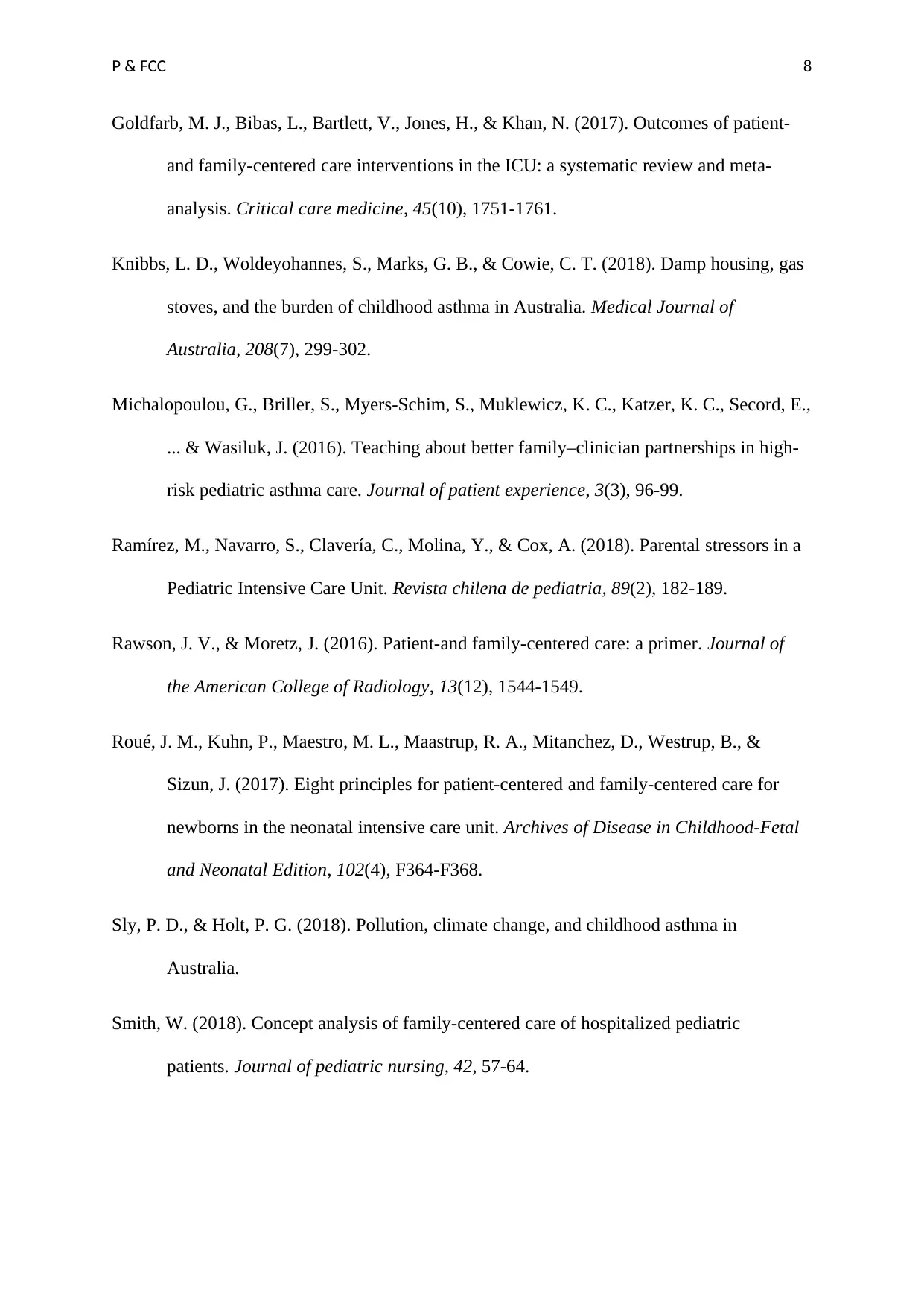
P & FCC 8
Goldfarb, M. J., Bibas, L., Bartlett, V., Jones, H., & Khan, N. (2017). Outcomes of patient-
and family-centered care interventions in the ICU: a systematic review and meta-
analysis. Critical care medicine, 45(10), 1751-1761.
Knibbs, L. D., Woldeyohannes, S., Marks, G. B., & Cowie, C. T. (2018). Damp housing, gas
stoves, and the burden of childhood asthma in Australia. Medical Journal of
Australia, 208(7), 299-302.
Michalopoulou, G., Briller, S., Myers-Schim, S., Muklewicz, K. C., Katzer, K. C., Secord, E.,
... & Wasiluk, J. (2016). Teaching about better family–clinician partnerships in high-
risk pediatric asthma care. Journal of patient experience, 3(3), 96-99.
Ramírez, M., Navarro, S., Clavería, C., Molina, Y., & Cox, A. (2018). Parental stressors in a
Pediatric Intensive Care Unit. Revista chilena de pediatria, 89(2), 182-189.
Rawson, J. V., & Moretz, J. (2016). Patient-and family-centered care: a primer. Journal of
the American College of Radiology, 13(12), 1544-1549.
Roué, J. M., Kuhn, P., Maestro, M. L., Maastrup, R. A., Mitanchez, D., Westrup, B., &
Sizun, J. (2017). Eight principles for patient-centered and family-centered care for
newborns in the neonatal intensive care unit. Archives of Disease in Childhood-Fetal
and Neonatal Edition, 102(4), F364-F368.
Sly, P. D., & Holt, P. G. (2018). Pollution, climate change, and childhood asthma in
Australia.
Smith, W. (2018). Concept analysis of family-centered care of hospitalized pediatric
patients. Journal of pediatric nursing, 42, 57-64.
Goldfarb, M. J., Bibas, L., Bartlett, V., Jones, H., & Khan, N. (2017). Outcomes of patient-
and family-centered care interventions in the ICU: a systematic review and meta-
analysis. Critical care medicine, 45(10), 1751-1761.
Knibbs, L. D., Woldeyohannes, S., Marks, G. B., & Cowie, C. T. (2018). Damp housing, gas
stoves, and the burden of childhood asthma in Australia. Medical Journal of
Australia, 208(7), 299-302.
Michalopoulou, G., Briller, S., Myers-Schim, S., Muklewicz, K. C., Katzer, K. C., Secord, E.,
... & Wasiluk, J. (2016). Teaching about better family–clinician partnerships in high-
risk pediatric asthma care. Journal of patient experience, 3(3), 96-99.
Ramírez, M., Navarro, S., Clavería, C., Molina, Y., & Cox, A. (2018). Parental stressors in a
Pediatric Intensive Care Unit. Revista chilena de pediatria, 89(2), 182-189.
Rawson, J. V., & Moretz, J. (2016). Patient-and family-centered care: a primer. Journal of
the American College of Radiology, 13(12), 1544-1549.
Roué, J. M., Kuhn, P., Maestro, M. L., Maastrup, R. A., Mitanchez, D., Westrup, B., &
Sizun, J. (2017). Eight principles for patient-centered and family-centered care for
newborns in the neonatal intensive care unit. Archives of Disease in Childhood-Fetal
and Neonatal Edition, 102(4), F364-F368.
Sly, P. D., & Holt, P. G. (2018). Pollution, climate change, and childhood asthma in
Australia.
Smith, W. (2018). Concept analysis of family-centered care of hospitalized pediatric
patients. Journal of pediatric nursing, 42, 57-64.
⊘ This is a preview!⊘
Do you want full access?
Subscribe today to unlock all pages.

Trusted by 1+ million students worldwide
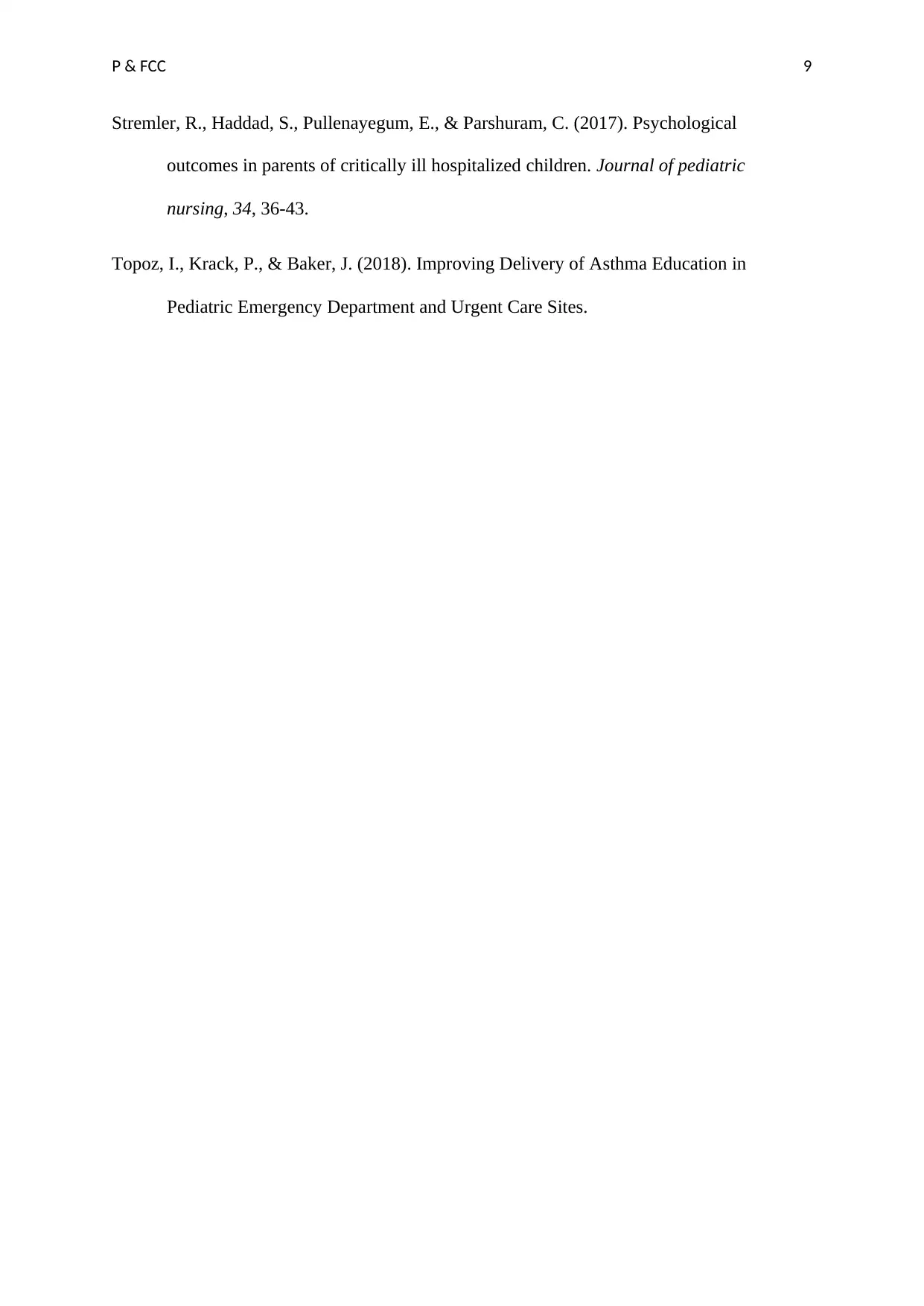
P & FCC 9
Stremler, R., Haddad, S., Pullenayegum, E., & Parshuram, C. (2017). Psychological
outcomes in parents of critically ill hospitalized children. Journal of pediatric
nursing, 34, 36-43.
Topoz, I., Krack, P., & Baker, J. (2018). Improving Delivery of Asthma Education in
Pediatric Emergency Department and Urgent Care Sites.
Stremler, R., Haddad, S., Pullenayegum, E., & Parshuram, C. (2017). Psychological
outcomes in parents of critically ill hospitalized children. Journal of pediatric
nursing, 34, 36-43.
Topoz, I., Krack, P., & Baker, J. (2018). Improving Delivery of Asthma Education in
Pediatric Emergency Department and Urgent Care Sites.
1 out of 10
Related Documents
Your All-in-One AI-Powered Toolkit for Academic Success.
+13062052269
info@desklib.com
Available 24*7 on WhatsApp / Email
![[object Object]](/_next/static/media/star-bottom.7253800d.svg)
Unlock your academic potential
Copyright © 2020–2025 A2Z Services. All Rights Reserved. Developed and managed by ZUCOL.



